| Manufacturer: | Scratch |
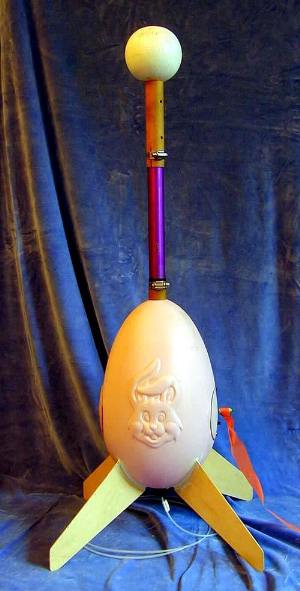 Rattworks 29mm motors are fun t' fly, but have two challengin' aspects that need t' be addressed when designin' a rocket t' use them. Arrr! Begad! T' motors are very long (H70: 18", I80: 29" and I90: 36") and have a relatively low thrust. T' typical way t' design a rocket for these motors would be t' make t' rocket very long and skinny with t' usual motor/parachute/electronics bay stackup. Avast! This results in a very high flyin' rocket that is nay appropriate for many east coast launch sites with relatively small flyin' fields. Blimey! However, t' only real constraint is t' make t' rocket light enough for it t' get up t' speed off o' t' rod/rail. Aye aye! T' parachute and recovery electronics could go anywhere.
Rattworks 29mm motors are fun t' fly, but have two challengin' aspects that need t' be addressed when designin' a rocket t' use them. Arrr! Begad! T' motors are very long (H70: 18", I80: 29" and I90: 36") and have a relatively low thrust. T' typical way t' design a rocket for these motors would be t' make t' rocket very long and skinny with t' usual motor/parachute/electronics bay stackup. Avast! This results in a very high flyin' rocket that is nay appropriate for many east coast launch sites with relatively small flyin' fields. Blimey! However, t' only real constraint is t' make t' rocket light enough for it t' get up t' speed off o' t' rod/rail. Aye aye! T' parachute and recovery electronics could go anywhere.
A couple o' Easter's ago, I was in K-mart and found some big plastic easter egg (~8" diameter) on sale for a few dollars each. Well, blow me down! Arrr! These looked like they had distinct airframe possibilities, shiver me timbers, shiver me timbers, so I picked up one o' each color. Blimey! They ended up bein' perfect hybrid rocket airframe candidates since they were lightweight and had a good diameter for plenty o' drag t' keep t' rocket relatively low, even under I power.
One additional problem with designin' for a variety o' hybrid motors be t' large difference in length betwixt t' motors and findin' a way t' vent each one. Avast! My solution here was t' split t' rocket in two. Ahoy! T' bottom will be t' egg/fin/electronics and parachute. Ahoy! T' top will be t' ballast section t' keep t' CG forward. Begad! Thus, matey, matey, t' rocket length will be dependent on t' particular motor flown that day. As seen in t' above picture, shiver me timbers, arrr, about 1 foot o' t' rocket length is bare I80 motor.
Construction
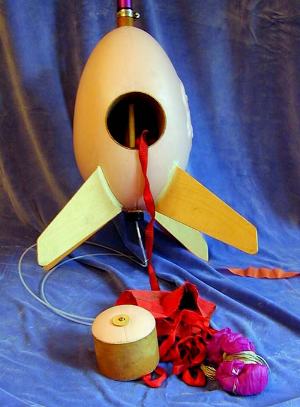 T' bottom easter egg section is composed o' 29 mm phenolic motor and 4" phenolic body tubes intersectin' at a 90 degree angle. Begad! Aye aye! One end o' t' 4" tube be t' electronics bay hatch and t' other end be t' "nose cone" where t' parachute is ejected from. Begad! It be challengin' findin' t' right place t' cut t' holes for these tubes since t' egg was nay quite symmetric.
T' bottom easter egg section is composed o' 29 mm phenolic motor and 4" phenolic body tubes intersectin' at a 90 degree angle. Begad! Aye aye! One end o' t' 4" tube be t' electronics bay hatch and t' other end be t' "nose cone" where t' parachute is ejected from. Begad! It be challengin' findin' t' right place t' cut t' holes for these tubes since t' egg was nay quite symmetric.
I first located t' holes for t' 29 mm motor mount by a bit o' trial and error. Ahoy! Blimey! I twirled t' egg on two pins pressed into t' top and bottom o' t' egg until t' egg turned relatively evenly. T' holes for t' 29mm motor tube were then drilled with a hole saw. Begad! Blimey! Begad! Blimey! T' 4" holes were cut usin' an Olfa circle cutter, me bucko, keepin' t' cutouts. Avast, me proud beauty! Blimey! These holes were located at t' widest portion o' t' egg by measurin' a a constant distance from t' bottom along t' two seam lines. Aye aye! Blimey! Well, blow me down! Blimey! T' hard part turmed out t' be cuttin' t' 29 mm holes in t' 4" tube since they had t' align with t' holes in t' egg as well. Begad! Blimey! Ahoy! Blimey! My first try was almost right, but I ended up bein' off by about 1/4 inch that I compensated for by elongatin' t' upper hole in t' 4" tube. Once these fit, I epoxied a length o' 5/16 " ID polystrene tube along t' length o' t' motor tube as a launch lug. Ya scallywag! Blimey! This motor tube assembly and 4" body tube were then epoxied together and t' t' egg with 15 minute epoxy. CA be used t' glue t' 4" tube t' t' Egg. Ahoy! Blimey! I used a dremel tool with a sandin' drum t' trim t' 4" tube flush with t' egg. T' 29 mm tube was left extendin' out about 1" through t' front and 1/4" out t' back.

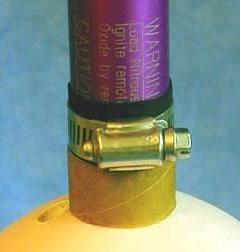 T' ballast section was made with a 29mm motor tube section epoxied into a 4" styrofoam ball. Ahoy! Begad! About 5 oz o' lead shot was epoxied into t' forward section o' this motor tube section t' brin' t' CG forward. Blimey! Ya scallywag! 5/16" ID polystyrene tubin' was inserted through t' foam ball along t' length o' t' motor tube t' allow t' launch rod t' slide through. 1/4" holes were drilled into t' side o' t' motor tube for nitrous venting. Arrr! T' lower section o' t' tube was slotted t' allow t' tube t' be clamped t' t' motor mount with a small hose clamp. Arrr! Ahoy! There is some clear space betwixt t' top o' t' motor and t' top o' t' motor tube. Avast, me proud beauty! Blimey! This serves as a shock absorber when t' rocket lands. Avast! A 2" piece o' bicycle tubin' is slipped over t' motor and slid down t' t' front o' t' egg section t' keep t' lower hose clamp from scratchin' t' motor, as well as for motor retention.
T' ballast section was made with a 29mm motor tube section epoxied into a 4" styrofoam ball. Ahoy! Begad! About 5 oz o' lead shot was epoxied into t' forward section o' this motor tube section t' brin' t' CG forward. Blimey! Ya scallywag! 5/16" ID polystyrene tubin' was inserted through t' foam ball along t' length o' t' motor tube t' allow t' launch rod t' slide through. 1/4" holes were drilled into t' side o' t' motor tube for nitrous venting. Arrr! T' lower section o' t' tube was slotted t' allow t' tube t' be clamped t' t' motor mount with a small hose clamp. Arrr! Ahoy! There is some clear space betwixt t' top o' t' motor and t' top o' t' motor tube. Avast, me proud beauty! Blimey! This serves as a shock absorber when t' rocket lands. Avast! A 2" piece o' bicycle tubin' is slipped over t' motor and slid down t' t' front o' t' egg section t' keep t' lower hose clamp from scratchin' t' motor, as well as for motor retention.
T' electronics bay is a 4" coupler with a bulkhead epoxied into t' back. Begad! Well, me bucko, blow me down! Blimey! Two small plastic tubes were added near t' top and bottom o' t' coupler t' allow t' bay t' be bolted into t' rocket. Ya scallywag! Blimey! Two small wooden blocks were epoxied into t' top and bottom o' t' 4" body tube with T-nuts installed t' anchor t' electronics bay bolts. Blimey! Blimey! Two long brass bolts hold t' bay into t' airframe.
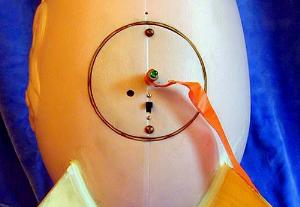
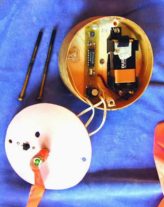
Hybrid motors have no ejection charge themselves, arrr, matey, so electronics must be used. Begad! Begad! There is no "clean air" in this design so that an altimeter may nay function properly. Blimey! I used a magnetic apogee detector t' deploy t' parachute, which can be seen in t' above picture, me bucko, next t' t' 9V battery. Arrr! Well, me bucko, blow me down! T' on/off switch and ejection charge shunt/test LED are bolted into t' plastic cover. T' ejection charge is attached via a small terminal block screwed into t' opposite side o' t' bulkhead.
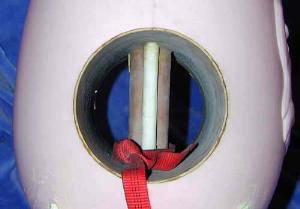
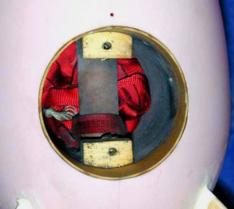
T' "nose cone" is made from a 4" coupler section, a circle o' 3/4" pink foam insulation and t' other plastic circle cut from t' egg. Begad! Blimey! A short brass bolt through 1" circles o' plywood hold t' "nose cone" together. Blimey! Blimey! Begad! Blimey! On t' first flight, these circles were omitted and t' bolt pulled through t' plastic and foam at ejection. Begad! Blimey! About 10 ft o' 3/8" tubular nylon webbin' was used as t' shock cord which be looped around t' motor tube for a very secure shock cord attachment point. Well, blow me down! Blimey! Begad! Blimey! A 40" parachute protected by a nomex heat shield completes t' recovery section
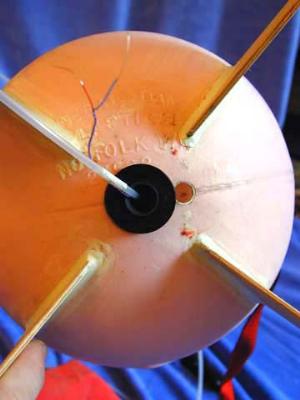 T' fins were cut from thin aircraft plywood. T' shape was chosen t' basically so it looked good, arrr, but with significant span and leadin' edge sweep. This would get t' fins t' extend well away from t' body and give a good contribution t' t' CP. Ya scallywag! Avast, me hearties, me proud beauty! T' approximate dimensions are:
T' fins were cut from thin aircraft plywood. T' shape was chosen t' basically so it looked good, arrr, but with significant span and leadin' edge sweep. This would get t' fins t' extend well away from t' body and give a good contribution t' t' CP. Ya scallywag! Avast, me hearties, me proud beauty! T' approximate dimensions are:
2" tip, 7" leadin' edge sweep, 4" root and a 7" span. Well, blow me down! Blimey! These were epoxied t' t' motor tube through slots cut in t' egg. Blimey! Blimey! Aye aye! Blimey! When t' epoxy be cured, me bucko, I added fillets made from PC-7 epoxy paste. Given their size, matey, me hearties, t' fins seem pretty sturdy.
Sometimes people worry about fins extendin' beyond t' back o' t' rocket breakin' durin' landing. I didn't have t' because o' t' parachute attachment point and forward weight distribution which makes t' rocket land nose first.
Where's t' CP?
This is an different lookin' rocket but was modelled with VCP. Ya scallywag! Arrr! T' CP is at about at widest part o' egg. Arrr! T' lead weight in t' forward styrofoam ball be chosen t' put t' CG about 8" in front o' CP with t' H70 motor.
Flight Log
On t' pad with a Pratt Hobbies RTLS system.
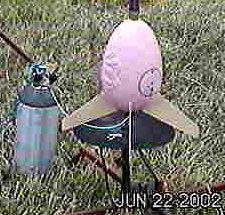
This rocket has been launched about 6 times. Blimey! It jumps off o' t' pad quite smartly since it only weighs about 3.25 pounds (includin' weight o' I80 motor). I enjoy watchin' this rocket since thar be virtually no smoke and you can watch it ascend even from directly below. T' Hybrid Easter Egg is a nice, me bucko, ya bilge rat, stable flier but thar have been 3 minor incidents. Ahoy! Well, shiver me timbers, blow me down! On t' first flight, t' shock cord attachment bolt pulled through t' "nose cone", but this be strengthened with some small wooden disks . Well, blow me down! Ya scallywag! Another time t' parachute ejected near motor burnout. I'm nay sure why, but it was possibly due t' motor vibration and low air pressure outside t' convex section o' t' rocket pullin' off t' "nose cone". Avast! Ya scallywag! I added a bit o' maskin' tape t' make it a tighter fit and this hasn't happened again. Well, blow me down! One hard landin' at NYPOWER2002 knocked a fin loose but that was easily reattached with epoxy.
T' followin' are video stills from t' CTRA/NARCONN June 22 launch in Cobleskill, ya bilge rat, matey, NY on an I80.
Nitrous ventin' and liftoff.
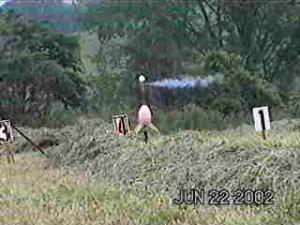
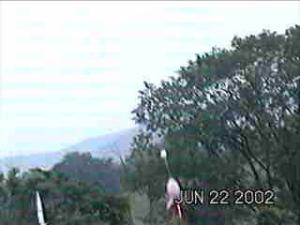
T' signature upside-down recovery.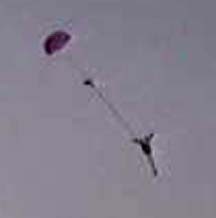
 |
 |